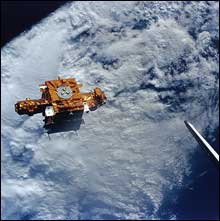Spartan 201
Full Name: Spartan
Phase: Past
Launch Date: September 13, 1994
Mission Project Home Page: http://heasarc.gsfc.nasa.gov/docs/heasarc/missions/spartan1.html
The Spartan spacecraft were a series of experiments carried by the Space Shuttle. They addressed a variety of scientific questions, and capitalized on the Space Shuttle's ability to accommodate long duration experiments that are large or heavy, or that require retrieval or other on-orbit operations. The Spartan program was based on the idea of a simple, low-cost platform deployed from a space shuttle in orbit for a 2-3 day flight, then recovered and returned to Earth. The platform freed experiments of any shuttle pointing constraints.
Spartan 101: High Energy Astrophysics experiment was flown June 1985 on STS-51-G. During its 2 days of flight, Spartan-1 observed the Perseus cluster of galaxies and our galactic center region.
The Spartan 201 spacecraft, which flew five times, carried two telescopes to study the Sun's extremely hot corona and its expansion into the solar wind. The telescopes were the Ultraviolet Coronal Spectrometer and the White Light Coronagraph. Ultraviolet Coronal Spectrometer used ultraviolet emissions from neutral hydrogen and ions in the corona to determine the velocities of the coronal plasma within the solar wind source region, and the temperature and density distributions of protons. The White Light Coronagraph measured visible light to determine the density distribution of coronal electrons within the same regions. Because the Earth's atmosphere interferes with emissions at these wavelengths, the measurements had to be made from space, rather than from the ground. The Spartan 201 spacecraft now resides at the National Air and Space Museum.
Spartan 203 Mission was a mission to observe of Comet Halley in ultraviolet. Spartan Halley was a quick response to provide ultra-violet observations of Comet Halley. The experiment and spacecraft were prepared for flight in just 14 months. It launched on STS-51-L January 1986.Spartan Halley was lost in the Challenger accident.
Spartan 204 Mission: UV Astronomy (Stellar) experiment was flown in February 1995 on STS-63. Spartan 204 carried a science instrument called the Far Ultraviolet Imaging Spectrograph, or FUVIS, provided by the Naval Research Laboratory (NRL) and sponsored by the Department of Defense Space Test Program. FUVIS obtained far ultraviolet spectroscopy of diffuse sources, both natural and man-made. The data acquired from natural sources such as diffuse nebulae and the galactic background provided information on interstellar gas and dust. Data acquired from man-made sources such as the shuttle surface glow and plume emissions from the Reaction Control System (RCS) thrusters provided information on the effect of man-made objects traveling through the space environment. A better understanding of these effects may provide a means for detecting and tracking ballistic and orbiting vehicles.

